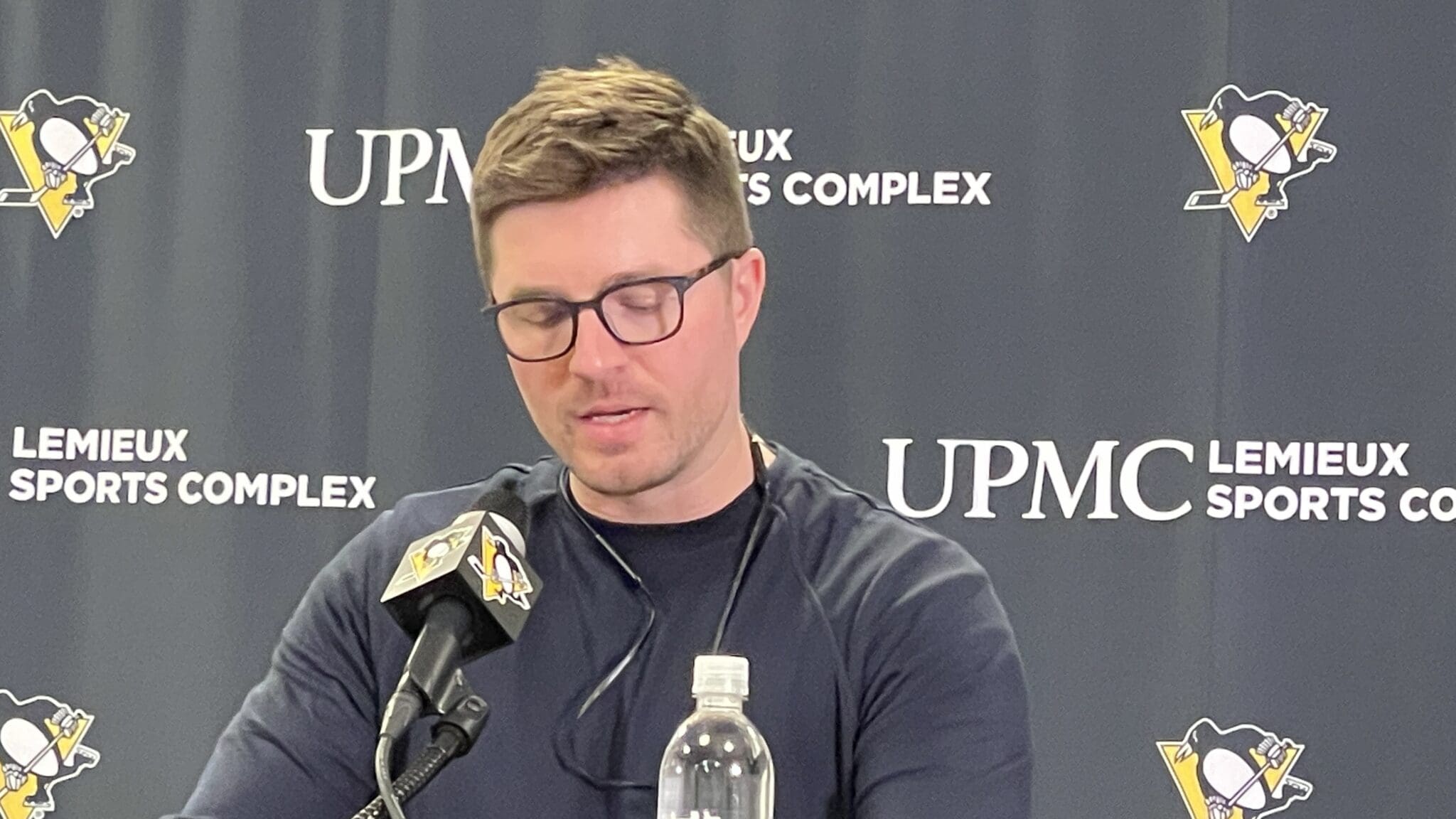Penguins
Penguins Offseason Plans: Trade Strategy, Complacency, & Past Mistakes

Can a group of players who are not complacent create a complacent atmosphere?
Pittsburgh Penguins general manager Kyle Dubas held a 35-minute presser Monday and delivered more direct, informative, and actionable answers than his first two years of press conferences combined. Dubas was obviously unhappy with not only his team’s dirt nap for all but two months of the season (December and March), but also uniquely unhappy that all of the players want to return.
After all, they were 11 points out of a playoff spot, and they are embarking on some form of rebuild. Why would so many players want to return to that?
The Penguins have now missed the playoffs three years running. In fact, the overwhelming desire to stick around despite the lack of success sent up red flags with the GM.
“I think that’s a testament to the community and the people around the organization that make it a great place to be, and the players are treated exceptionally well. (However) when I hear it, when this team, the team has missed the playoffs now three years in a row, I start to get this inner anxiety and fear that when you aren’t performing at a high level, when people still say that, you’re at the risk of complacency and stagnation setting in,” Dubas said. “That’s not to say that we need to stop doing things that way on the outside (but) we have to get back to increasing our level of expectation to get players to feel that way.”
With Dubas’s words, one could almost see him walking toward a few conclusions and significant change, though unspoken. In watching this unfold, in which a team’s general manager was unnerved that players were happy to return after a losing season, an unfortunate collision course of future and past actions emerged.
It’s a contradiction that appears Dubas will not be able to fix, only mitigate.
No Emotion
One thing about which Dubas was clear was that neither fan sentiment nor player desire would affect his decisions.
Neither Rickard Rakell nor Bryan Rust should expect to be with the Pittsburgh Penguins in the fall, but neither is their departure assured. If Dubas gets an offer that makes the team better, they go. If not, they stay. Dubas was given the chance (by this reporter) to praise or acknowledge in his decision-making process the deeply held desire to stay, which was loudly expressed by Rust and earnestly by Rakell, yet he essentially dismissed it.
Read More: Penguins Room: Rust Will Tell Anyone, ‘I Don’t Want to Leave’
However, Dubas seemed to indicate that at least Rust will be back because he bridges the leadership gap between Crosby and the young players, who may be a bit starstruck.
“Production-wise, they were at their best, but I think in terms of what they contribute defensively, they were both excellent for us the whole year. Their competitiveness, especially in Rusty’s case–he’s been here his whole career, his daily commitment to being an elite Pittsburgh Penguin and setting an example (is excellent),” Dubas said. “He also bridges the gap. One of the things we see here, especially with young guys, there’s such a reverence for (Sidney Crosby), who’s earned that reverence. So Rusty sets the example.
“And if you start to lose too many of those players, then you can get yourself into a bit of a quandary fast. And so, both of them set great examples, both are excellent players and people, members of the community.”
Fair enough. He was unflinching.
No one should be comfortable except for the few players who control their destiny, and Crosby. And in speaking with all of those players this season, even a couple of the players who control their fate did not dismiss the possibility of being traded this summer.
In addition to some pointed comments on Erik Karlsson, Dubas not-so-subtly tipped his offseason plans Monday at the UPMC Lemieux Complex. He clearly has big plans, though no deadlines, and some significant challenges to be competitive next season.
Biggest Problem: Defense
Dubas came out swinging Monday. In his opening remarks, he rightly admitted that the defense and the defensemen were THE major issue. He placed a good chunk of the goaltenders’ struggles on the lack of team defense and the struggling defensemen (all of whom he acquired, except for Kris Letang), and highlighted the need to improve the defense in order to improve the team.
“The defense group is an area of major concern at the NHL level and really with our prospect group. We’ve got a few guys in the prospect pool that have good potential. Some of them have been up for play, Owen Pickering, Jackson Ivany … it’s an area of major focus for us that we’re going to need to improve upon to return our team to contention,” Dubas said. “So what you’ll expect from us in the summer, the plan that we’ve set out in this room and publicly is that we’re going to continue down that path.
“I know that we have a lot of assets we could use, we have a lot of cap space we could use. We will use it if there are opportunities to bring in players that can be a part of returning the team to contention and then maintaining their level all the way through their contracts once in contention.”
Note the last sentence. Use that as a guide for any free agent.
However, the defensemen are his biggest problem in continuing to reshape the roster. His most problematic defenders, Karlsson and Ryan Graves, might very well be untradeable without sacrificing major assets or further handcuffing themselves to unwanted players in return.
Except for the likely loss of pending free agent Matt Grzelcyk, the beleaguered Penguins defense is exclusively under contract (Conor Timmins is an RFA), and all sides look like they are stuck with each other.
It’s kind of like having a few years left on a mortgage for a house that’s been condemned. Good luck.
Dubas is hopeful the young defenders in his system will help: Owen Pickering, Jack St. Ivany, and Harrison Brunicke. However, he also said defenseman prospects are not a strength of the organization, and they need to improve that, too. Indirectly, Dubas signaled he’ll be using his draft picks to acquire defensemen, either via restricted free agency or trade.
The Summer Plan
There will not be a massive teardown. Dubas cited the luck required in the lottery to achieve a turnaround from a complete teardown.
“There are two paths to go down. You can go into the mass tear down rebuild and hope you get lucky with the lottery and hope–you can hope in one hand and (pause) shit in the other and see which one fills up first,” Dubas said. “I think if you really look at it, (the Washington Capitals) also drafted well while they were contending. So you look at their roster now, it’s populated with their own younger guys that are in their early 20s.”
Dubas concluded.
“So we’ve got to haul ass and and try to catch them because they’re way ahead right now as the standings show, but they weren’t they weren’t two years ago.”
In describing how the Penguins will utilize their cap space, Dubas specifically avoided saying the team would sign RFAs. However, he described his offseason plans as specifically looking to trade for those players. He even referenced the St. Louis Blues signing Dylan Holloway and Philip Broberg away from the Edmonton Oilers as an example of changing league attitudes toward RFAs, but indicated the rising cap would increase the competition, so a Penguins trade for those players is more likely.
“I think (the rising cap) is going to allow us to maybe trade for players that other teams can’t afford, their restricted free agents, and then sign them longer range ourselves using cap space that way,” said Dubas. “So you’re signing a player that’s 23, 24 for seven or eight years versus going into free agency for someone who’s 27 to 32 and getting them for seven years. So I think that would be the more likely route if you were to see us (make a move). The owners have been excellent. There are no limitations on the player budget and spending.”
The Penguins have 15 picks in the top three rounds over the next three years. They can afford to spend a pick or two, and Dubas obviously will hit that market with vigor.
Bear in mind that signing an RFA requires giving up a pick commensurate with the salary. An RFA who signs for over $5 million (the NHL has not yet released the 2025 RFA compensation scale) would require the Penguins to forfeit their 2026 first-round pick. With Gavin McKenna as a potential prize, yeah, that ain’t happening.
But a trade for an RFA with a first-round compensation projection is intriguing.
It’s a little bit dated, and we’ll have to update the list soon, but here is PHN’s preliminary list of RFAs to watch.
The Collision
Oddly, Dubas noted that he considered bringing up Tristan Broz, but didn’t want Broz’s first NHL games to be in “that situation,” and didn’t want to leave Wilkes-Barre/Scranton shorthanded while also overloading the NHL roster with forwards.
But defensemen are the focus.
The RFA trade route is interesting, and Dubas has acquired enough draft picks to enter the arena, though the top RFAs are on teams with plenty of cap space, so like other moves, hope and reality, want and available, could collide.
Obviously, the Penguins’ situation is more optimistic than it was a year ago, but their problems on the blue line, which are in part Dubas’s making, remain nearly unsolvable and will remain that way. Just as his words cut straight to the point, so too must his actions. It seems he, too, is ready to stop nibbling on the edges and make big changes
But that’s where the past and future will collide.


